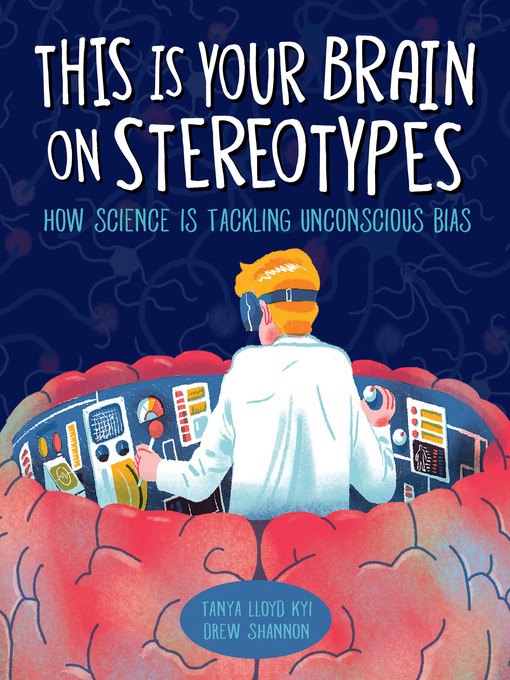An introduction to the science behind stereotypes.From the time we're babies, our brains sort and label the world around us—a necessary skill for survival. But there's a downside: we also do it to groups of people in ways that can be harmful. With loads of examples, here's a scientific overview of stereotyping, covering the history of identifying stereotypes, secret biases in our brains, how stereotypes affect our sense of self, and current research into the ways that science can help us overcome them. Adolescents are all too familiar with stereotypes. Here's why our brains create stereotypes, and how science can help us do it less.
This Is Your Brain on Stereotypes
How Science Is Tackling Unconscious Bias
-
Creators
-
Publisher
-
Release date
September 1, 2020 -
Formats
-
OverDrive Read
- ISBN: 9781525306112
-
-
Languages
- English
-
Levels
- ATOS Level: 6.8
- Lexile® Measure: 910
- Interest Level: 6-12(MG+)
- Text Difficulty: 4-5
-
Reviews
-
School Library Journal
August 1, 2020
Gr 5-8-This primer for upper elementary and middle school students explains the science, history, and psychology of stereotypes. The book's five chapters make this a manageable read for young readers. Additionally, Shannon's bright illustrations and sidebars break up the succinct chapters. Kyi often asks questions to illustrate her point and to help readers identify their own biases, creating an interactive reading experience. Topics about stereotypes surrounding gender, race, class, and political and religious beliefs are addressed. Studies or historical examples from various periods and geographic locations are used to solidify the text. The final chapter focuses on ways that people have fought against stereotypes; a list of suggestions on how to unlearn biases is featured. Back matter includes a list of additional resources, selected resources for each chapter, and a well-constructed index. VERDICT A worthwhile purchase for middle grade collections that will help readers recognize, understand, and eradicate stereotypes.-Katharine Gatcomb, Portsmouth P.L., NH
Copyright 2020 School Library Journal, LLC Used with permission.
-
Kirkus
Starred review from July 1, 2020
Bias, discrimination, prejudice, and stereotypes start developing early in the brain; research shows these can change with effort. Through the lens of scientific research, Kyi examines how brains are wired toward bias, how stereotypes emerge, and the effects on those being stereotyped, especially when it comes to race, gender, and sexual orientation. Taking a global perspective but often pointing to how problems have manifested in the United States, the book highlights the harmful and sometimes lethal ways stereotypes manifest in daily life, policing, and health care. Information is well organized, backed by examples, and, by focusing on the individual experience, refrains from centering whiteness. Offering historical context via such disparate examples as eugenics, Dr. Seuss, and the Rwandan genocide, Kyi illustrates "affective contagion," emphasizing how leaders play a part in perpetuating stereotypes, and brings into the discussion the powerful role the media have in sustaining or diminishing stereotypes. She identifies the impacts of "stereotype threat," when an individual is afraid of confirming someone's stereotypes about them, and gives examples of how those in the position of power can offset it. After noting that an individual must be motivated to see their biases and wish to change, the book ends with concrete actions readers can take to begin rewiring their brains from the stereotypes they've internalized. A must-read primer for change. (further reading, selected resources, index) (Nonfiction. 10-16)COPYRIGHT(2020) Kirkus Reviews, ALL RIGHTS RESERVED.
-
Booklist
July 1, 2020
Grades 6-9 As businesses, schools, and other communities consider the impact of unconscious bias, why not get young people thinking about its causes and effects, too? This informational book does just that, breaking down this complicated subject into short, easy-to-comprehend sections. Following an introduction that recognizes how the brain naturally sorts objects?by types of clothing or food, for example?the author delves into the harmful ways that people might sort individuals or groups, particularly through racism and sexism. She begins with easier concepts, such as stereotypes and prejudice, and builds up to more detailed and related concepts like implicit bias and affective contagion. The author uses fascinating scientific research to provide context. For instance, in an experiment featuring a video game in which players shoot gun-toting bad guys but not cell phone-toting good guys, participants showed overwhelming racial bias, shooting more armed Black men than armed white men. The text concludes on a more hopeful note, emphasizing the benefits of overcoming bias, the science that backs up these positive outcomes, and tips to make it happen.(Reprinted with permission of Booklist, copyright 2020, American Library Association.)
-
Formats
- OverDrive Read
subjects
Languages
- English
Levels
- ATOS Level:6.8
- Lexile® Measure:910
- Interest Level:6-12(MG+)
- Text Difficulty:4-5
Loading
Why is availability limited?
×Availability can change throughout the month based on the library's budget. You can still place a hold on the title, and your hold will be automatically filled as soon as the title is available again.
The Kindle Book format for this title is not supported on:
×Read-along ebook
×The OverDrive Read format of this ebook has professional narration that plays while you read in your browser. Learn more here.



